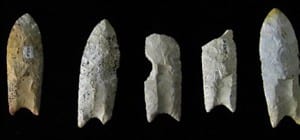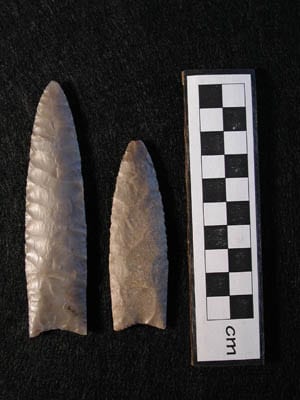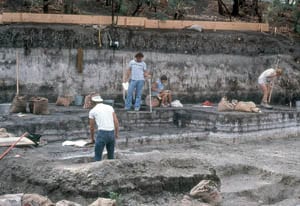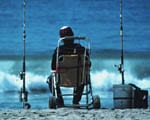Archaeologists who interpret Stone Age culture from discoveries of ancient tools and artifacts may need to reanalyze some of their conclusions.
Archaeologists who interpret Stone Age culture from discoveries of ancient tools and artifacts may need to reanalyze some of their conclusions.
That’s the finding suggested by a new study that for the first time looked at the impact of water buffalo and goats trampling artifacts into mud.
In seeking to understand how much artifacts can be disturbed, the new study documented how animal trampling in a water-saturated area can result in an alarming amount of disturbance, says archaeologist Metin I. Eren, a graduate student at Southern Methodist University and one of eight researchers on the study.
In a startling finding, the animals’ hooves pushed artifacts as much as 21 centimeters into the ground — a variation that could equate to a difference of thousands of years for a scientist interpreting a site, said Erin.
The findings suggest archaeologists should reanalyze some previous discoveries, he said.
“Given that during the Lower and most of the Middle Pleistocene, hominids stayed close to water sources, we cannot help but wonder how prevalent saturated substrate trampling might be, and how it has affected the context, and resulting interpretation, of Paleolithic sites throughout the Old World,” conclude the authors in a scientific paper detailing their experiment and its findings.
“Experimental Examination of Animal Trampling Effects on Artifact Movement in Dry and Water Saturated Substrates: A Test Case from South India” has been published online by the Journal of Archaeological Science. For images, additional information and a link to the article, see www.smuresearch.com. The research was recognized as best student poster at the 2010 annual meeting of the Society for American Archaeology.
Animal trampling not new; current study adds new variable
The idea that animal trampling may reorient artifacts is not new.
“Believe it or not, there have been dozens of trampling experiments in archaeology to see how artifacts may be affected by animals walking over them. These have involved human trampling and the trampling of all sorts of animals, including elephants, in dry sediments,” Eren said. “Our trampling experiments in dry sediments, for the most part, mimicked the results of previous experiments.”
But this latest study added a new variable to the mix — the trampling of artifacts embedded in ground saturated with water, Eren said.
Researchers from the United States, Britain, Australia and India were inspired to perform the unique experiment while doing archaeological survey work in the Jurreru River Valley in Southern India.
They noticed that peppering the valley floor were hardened hoof prints left from the previous monsoon season, as well as fresh prints along the stream banks. Seeing that the tracks sunk quite deeply into the ground, the researchers began to suspect that stone artifacts scattered on the edges of water bodies could be displaced significantly from their original location by animal trampling.
Early humans drawn to water’s edge
“Prehistoric humans often camped near water sources or in areas that receive lots of seasonal rain. When we saw those deep footprints left over from the previous monsoon season, it occurred to us that animal trampling in muddy, saturated sediments might distort artifacts in a different way than dry sediments,” Eren said. “Given the importance of artifact context in the interpretation of archaeological sites and age, it seems like an obvious thing to test for, but to our surprise it never had been.”
Eren and seven other researchers tested their theory by scattering replicated stone tools over both dry and saturated areas of the valley. They then had water buffalo and goats trample the “sites.” Once sufficient trampling occurred, the archaeologists proceeded to excavate the tools, taking careful measurements of where the tools were located and their inclination in the ground.
The researchers found that tools salted on ground saturated with water and trampled by buffalo moved up to 21 centimeters vertically, or a little more than 8 inches. Tools trampled by goats moved up to 16 centimeters vertically, or just over 6 inches.
“A vertical displacement of 21 centimeters in some cases might equal thousands of years when we try to figure out the age of an artifact,” Eren said. “This amount of disturbance is more than any previously documented experiment — and certainly more than we anticipated.”
A new “diagnostic marker” for interpreting sites
Unfortunately for archaeologists who study the Stone Age, artifacts left behind by prehistoric humans do not stay put, said Eren. Over thousands or even millions of years, all sorts of geological or other processes can move artifacts out of place, he said.
The movement distorts the cultural and behavioral information that is contained in the original artifact patterning, what archaeologists call “context.” Archaeologists must discern whether artifacts are in their original context, and thus provide reliable information, or if they’ve been disturbed in some way that biases the interpretation, Eren said.
Given that artifacts embedded in the ground at vertical angles appear to be a diagnostic marker of trampling disturbance, the researchers concluded that sites with water-saturated sediments should be identified and reanalyzed.
Other researchers on the study include Adam Durant, University of Cambridge; Christina Neudorf, University of Wollongong; Michael Haslam, University of Oxford; Ceri Shipton, Monash University; Janardhana Bora, Karnatak University; Ravi Korisettar, Karnatak University; and Michael Petraglia, University of Oxford. Korisettar and Petraglia are the principal investigators of the archaeological field research in Kurnool, India.
The research was funded by Leverhulme Trust, British Academy, National Science Foundation, Australian Research Council, National Science Foundation Graduate Research Fellowship Program, and Lockheed Martin Corporation.
A private university located in the heart of Dallas, SMU is building on the vision of its founders, who in 1911 imagined a distinguished center for learning emerging from the spirit of the city. Today, nearly 11,000 students benefit from the national opportunities and international reach afforded by the quality of SMU’s seven degree-granting schools.
SMU has an uplink facility located on campus for live TV, radio, or online interviews. To speak with Metin I. Eren or to book a live or taped interview in the studio, call SMU News & Communications at 214-768-7650 or email news@smu.edu.












